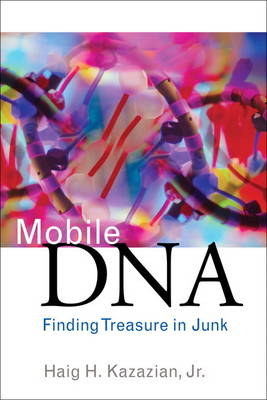
Mobile DNA
Financial Times Prentice Hall (Verlag)
978-0-13-707062-6 (ISBN)
- Titel ist leider vergriffen;
keine Neuauflage - Artikel merken
Kazazian introduces the key strategies and approaches taken in leading laboratories (including his own) to gain greater insight into the large proportion of our genome that derives from mobile genetic elements, including viruses, plasmids, and transposons. He also presents intriguing insights into long-term research strategies that may lead to an even deeper understanding.
Haig H. Kazazian, Jr. received his A.B. degree from Dartmouth College in 1959. He then attended Dartmouth Medical School, a two-year school at the time, and finished his M.D. degree at Johns Hopkins University School of Medicine. At Hopkins, he met his wife of nearly 50 years and married during his internship in Pediatrics at the University of Minnesota Hospital. After two years training in Minneapolis, he returned to Johns Hopkins for a two-year fellowship in genetics with Barton Childs, M.D. He then trained for two years in molecular biology in the lab of Harvey Itano, M.D., at the NIH. After a third year of Pediatric training at Johns Hopkins, he joined the faculty there in 1969. He rose through the ranks to become a full professor in 1977, and at that time, he headed the Pediatric Genetics Unit. In 1988, he became Director of the Center for Medical Genetics at Johns Hopkins. After 25 years on the Hopkins faculty, he was recruited to the University of Pennsylvania School of Medicine as Chair of the Department of Genetics in 1994. At Penn, he recruited 10 young faculty to the department. In 2006, he stepped down as department chair, but remained as the Seymour Gray Professor of Molecular Medicine in Genetics until 2010. In July 2010, he returned to Johns Hopkins as a Professor in the Institute of Genetic Medicine. Dr. Kazazian is still heavily involved in molecular genetic research, concentrating for the past 20 years on mammalian and human transposable elements, or “jumping genes.” Prior to 1988, he characterized much of the variation in the cluster of genes involved in production of the beta chain of human hemoglobin. With Stuart Orkin at Harvard, his work led to the nearly complete characterization of the mutations causing the ß-thalassemias, common anemias in regions of the world endemic for malaria. Dr. Kazazian is a member of a number of national organizations, including the Institute of Medicine of the National Academy of Sciences and the American Academy of Arts and Sciences. He has received a number of honors for his research, most notably the 2008 William Allan Award, the top honor of the American Society of Human Genetics.
Preface: Thoughts on Doing Science xii
Chapter 1 Introduction to Mobile DNA 1
Chapter 2 Varieties of Mobile DNA 5
Chapter 3 DNA Transposons 19
Chapter 4 Mobile DNA of Model Organisms 29
Chapter 5 Exceptional Scientists Working on Mobile DNA in Lower Organisms 35
Chapter 6 Role of Bioinformatics in Genome Analysis 43
Chapter 7 The Prologue 49
Chapter 8 “Welcome to the Wonderful World of LINEs” 59
Chapter 9 An Experimental Breakthrough 73
Chapter 10 Reverse Transcriptase to the Rescue 81
Chapter 11 A Quirk of L1 Elements–A Lousy 3’ End Is Important for Genome Evolution 85
Chapter 12 A Tour de Force from Tom Eickbush 89
Chapter 13 “I don’t believe all those colonies represent retrotransposition events.” 93
Chapter 14 L1 Encodes an Endonuclease 101
Chapter 15 The Jocks 105
Chapter 16 The Mayor and the Frenchman 115
Chapter 17 Ostertag’s Coups 121
Chapter 18 The Independent Canadian 133
Chapter 19 The Musician Scientist 141
Chapter 20 Young Ladies in the Back Bay 145
Chapter 21 The Brilliant Young Lady from China 157
Chapter 22 Hiroki’s Big Surprises 163
Chapter 23 A Young Man with a Purpose 173
Chapter 24 Other Mobile DNA in Mammalian Genomes 179
Chapter 25 Effects of Retrotransposons on Mammalian Genomes 187
Chapter 26 Host Factors Involved in L1 Retrotransposition 201
Chapter 27 Why Mobile DNA? 207
Chapter 28 The Future of Mobile DNA Research 209
Chapter 29 Predictions for Mobile DNA 221
References 225
Glossary 249
Index 255
| Erscheint lt. Verlag | 7.7.2011 |
|---|---|
| Verlagsort | Upper Saddle River |
| Sprache | englisch |
| Maße | 161 x 234 mm |
| Gewicht | 500 g |
| Themenwelt | Informatik ► Weitere Themen ► Bioinformatik |
| Naturwissenschaften ► Biologie ► Genetik / Molekularbiologie | |
| Schlagworte | DNS (Desoxyribonukleinsäure) |
| ISBN-10 | 0-13-707062-4 / 0137070624 |
| ISBN-13 | 978-0-13-707062-6 / 9780137070626 |
| Zustand | Neuware |
| Haben Sie eine Frage zum Produkt? |
aus dem Bereich


